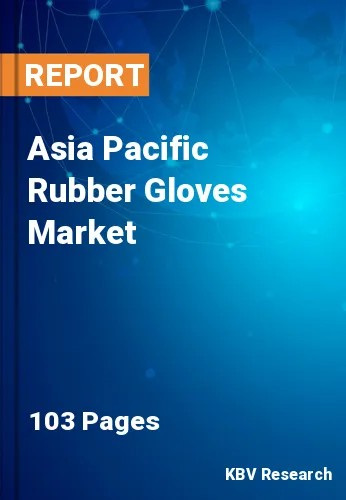The Asia Pacific Rubber Gloves Market would witness market growth of 4.2% CAGR during the forecast period (2022-2028).
Manufacturers include sulfur, zinc oxide, accelerators, colors, stabilizers, a de-webbing agent, and antioxidants among the compounds added to the latex. These compounds enable rubber to maintain a solid surface while being stretched, preventing the formation of holes. They also increase the rubber's resistance to the sun's UV rays. After maturing for 24 to 36 hours, the latex is ready for dipping.
Moreover, latex is typically tinted with specific colors before it hardens. Latex-dipped items, such as medical gloves and condoms, are particularly efficient against germs, such as bacteria and viruses, and are also impermeable to infectious fluids. However, latex made from natural rubber is a frequent allergy. Nitrile and vinyl gloves do not contain the proteins present in natural latex, therefore those with a latex allergy can use them without issue.
Nitrile gloves are created from synthetic rubber and provide a good barrier against viruses, chemicals, and caustic substances. They do not have the potential to cause allergic reactions, unlike latex. Nitrile is a co-polymer composed of butadiene and acrylonitrile. The nitrile used in disposable gloves is resistant to most petroleum-based lubricants and hydrocarbon fuels because it contains more acrylic than butadiene. Through the ammoxidation process, large quantities of acrylonitrile, an important synthetic chemical derived from propylene, are created. This method is utilized to produce textiles, resins, and polymers.
The top six natural rubber-producing countries in the world are Thailand, Indonesia, Malaysia, India, Vietnam, and China. Together, these countries account for around 86% of the world's natural rubber output. As a direct result of this, the majority of the world's most successful natural rubber manufacturers may be found in Southeast Asia. At the moment, the bulk of natural rubber is obtained from the Hevea brasiliensis tree, also known as the para rubber tree. Incisions are created into the bark of the tree to harvest isoprene polymers, which are a natural product.
The China market dominated the Asia Pacific Rubber Gloves Market by Country in 2021; thereby, achieving a market value of $1.4 billion by 2028. The Japan market is showcasing a CAGR of 3.5% during (2022 - 2028). Additionally, The India market would register a CAGR of 4.8% during (2022 - 2028).
Based on Product, the market is segmented into Disposable and Durable. Based on Material, the market is segmented into Natural Rubber/Latex, Nitrile, Neoprene and Others. Based on Type, the market is segmented into Powdered and Powder-free. Based on Distribution Channel, the market is segmented into Offline and Online. Based on End-use, the market is segmented into Medical & Healthcare, Automotive, Chemical & Petrochemical, Metal & Machinery, Oil & Gas, Pharmaceutical, Cleanroom, Food & Beverage and Others. Based on countries, the market is segmented into China, Japan, India, South Korea, Singapore, Malaysia, and Rest of Asia Pacific.
Free Valuable Insights: The Worldwide Rubber Gloves Market is Projected to reach USD 16.4 Billion by 2028, at a CAGR of 3.5%
The market research report covers the analysis of key stake holders of the market. Key companies profiled in the report include Ansell Ltd., Kimberly-Clark Corp., Unigloves Ltd., MCR Safety, Top Glove Corporation Bhd, Hartalega Holdings Berhad, The Glove Company, MAPA Professional, Adenna LLC and Atlantic Safety Products, Inc.
By Product
By Material
By Type
By Distribution Channel
By End-use
By Country
Our team of dedicated experts can provide you with attractive expansion opportunities for your business.

